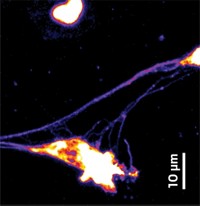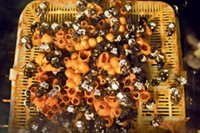Advertisement
Grab your lab coat. Let's get started
Welcome!
Welcome!
Create an account below to get 6 C&EN articles per month, receive newsletters and more - all free.
It seems this is your first time logging in online. Please enter the following information to continue.
As an ACS member you automatically get access to this site. All we need is few more details to create your reading experience.
Not you? Sign in with a different account.
Not you? Sign in with a different account.
ERROR 1
ERROR 1
ERROR 2
ERROR 2
ERROR 2
ERROR 2
ERROR 2
Password and Confirm password must match.
If you have an ACS member number, please enter it here so we can link this account to your membership. (optional)
ERROR 2
ACS values your privacy. By submitting your information, you are gaining access to C&EN and subscribing to our weekly newsletter. We use the information you provide to make your reading experience better, and we will never sell your data to third party members.
Biochemistry
When good bees go bad
Researchers identify neuropeptides linked to aggression in Africanized honeybees
by Emma Hiolski, special to C&EN
June 20, 2018
Honeybee aggression often ends with a sting, but where does it start?

Researchers in Brazil have identified peptides in the brains of Africanized honeybees that are linked to aggressive behavior and are capable of making even docile bees attack (J. Proteome Res. 2018, DOI: 10.1021/acs.jproteome.8b00098). These neuropeptides are snippets of precursor proteins present in the brains of relaxed bees, says Mario Sergio Palma of São Paulo State University. When the bees mount an attack, enzymes clip the precursor proteins into smaller fragments, initiating a physiological cascade that supports the defense of the hive.
About 60 years ago, honeybees brought to Brazil from Africa were accidentally released, and they started interbreeding with local honeybees. These Africanized bees form defensive swarms more rapidly and attack intruders more aggressively than the subspecies of honeybee commonly found in North and South America. Colonies of these bees—often referred to as “killer bees”—have spread through South America and moved northward ever since. They have been spotted in the U.S states of Texas, Arizona, and California.
Honeybees have a complex physiological and behavioral response to perceived threats. Guard bees release alarm pheromones to alert other worker bees and coordinate a collective attack. But not all honeybees in a colony answer the call to action. Age-related changes in gene expression shuffle bees through a series of roles within the colony. Young bees only work within the hive until they are 15 to 20 days old, when they become foragers and guards working outside the hive.
To better understand the origins of this complex defensive behavior, Palma’s team first collected aggressive bees from a research colony of Africanized honeybees (Apis mellifera). To accomplish this daunting task, the researchers waved black leather balls in front of the colony to trigger an attack; any bees that stung the target became stuck in the soft leather by their barbed stingers.
The researchers then analyzed the brains—each only 1 mm3—of both the aggressive bees and bees of the same age from the same colony that did not attack the leather ball. Using matrix-assisted laser desorption ionization (MALDI) mass spectral imaging, they scanned slices of the bee brains to create two-dimensional maps of the location and relative abundance of two precursor proteins known to be important in bee brain signaling and of four fragments of those proteins. Compared with nonaggressive bees, the aggressive bees showed reduced levels of the precursor proteins allatostatin A and tachykinin-related peptide and higher levels of the cleaved neuropeptides.
To determine whether these fragments play a role in initiating aggressive behavior, the team synthesized two of the neuropeptides and injected them, separately, into seven-day-old bees. Both a snippet of allatostatin A and one of tachykinin-related peptide caused the bees to become aggressive almost immediately. This was especially surprising, Palma says, because bees of that age are inside the hive doing maintenance and care work and are not expected to be aggressive at all.
Advertisement
Morgane Nouvian, a honeybee neuropeptide expert at the University of Konstanz, says the work is an important starting point that both identifies key neuropeptides and provides a mechanism for their rapid increase in the brain. “Future studies should investigate the receptor side of these neuromodulators to identify more clearly their targets,” she says.





Join the conversation
Contact the reporter
Submit a Letter to the Editor for publication
Engage with us on Twitter